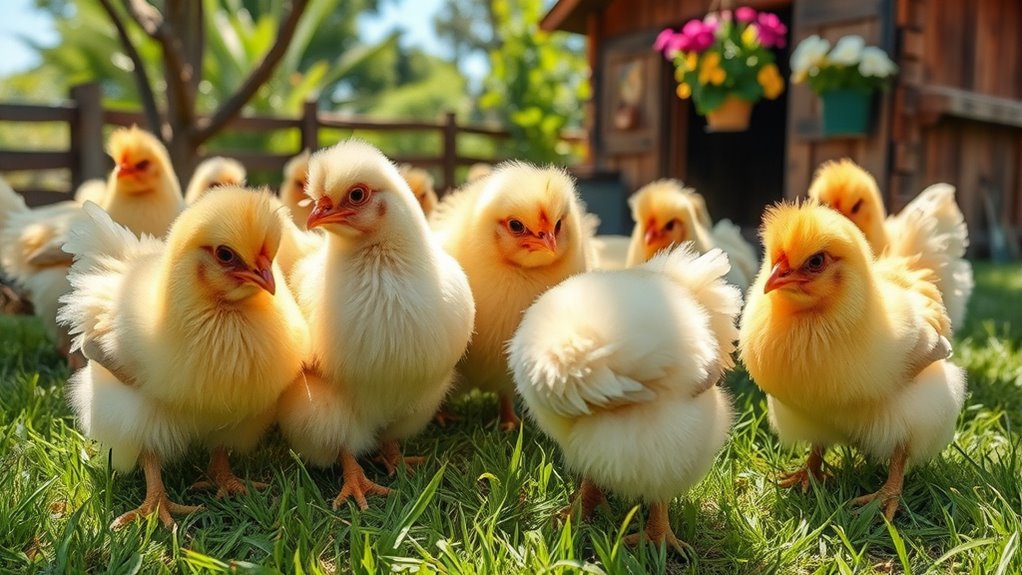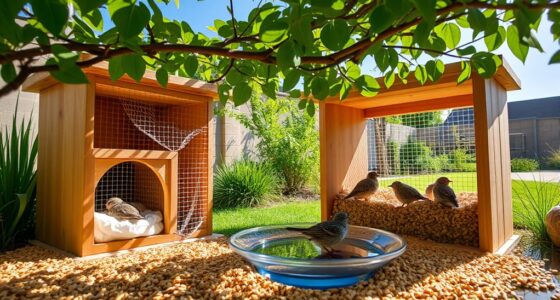Fluffy chickens, like Silkies and Cochins, add charm and beauty to your flock. These breeds feature soft feathers and friendly temperaments, making them great companions. Ensure they have a secure coop with adequate space and ventilation, and monitor their health for pests and temperature sensitivities. A protein-rich diet will keep them healthy and promote vibrant feathers. If you're curious about more essential care tips and unique characteristics, there's plenty more to explore.
Key Takeaways
- Popular fluffy chicken breeds include Silkies, Cochins, Faverolles, Polish, and Brahmas, each with unique characteristics and appearances.
- Fluffy chickens require a secure coop with 2-4 square feet per bird and an outdoor run of 8-10 square feet.
- Maintain coop temperatures between 65–75°F to prevent health issues, especially for breeds sensitive to temperature fluctuations.
- A protein-rich diet of 16-20% is essential for healthy feathers, along with access to fresh water at all times.
- Regular health checks for mites and frostbite are crucial due to their dense plumage and sensitivity to extreme weather.
Popular Fluffy Chicken Breeds
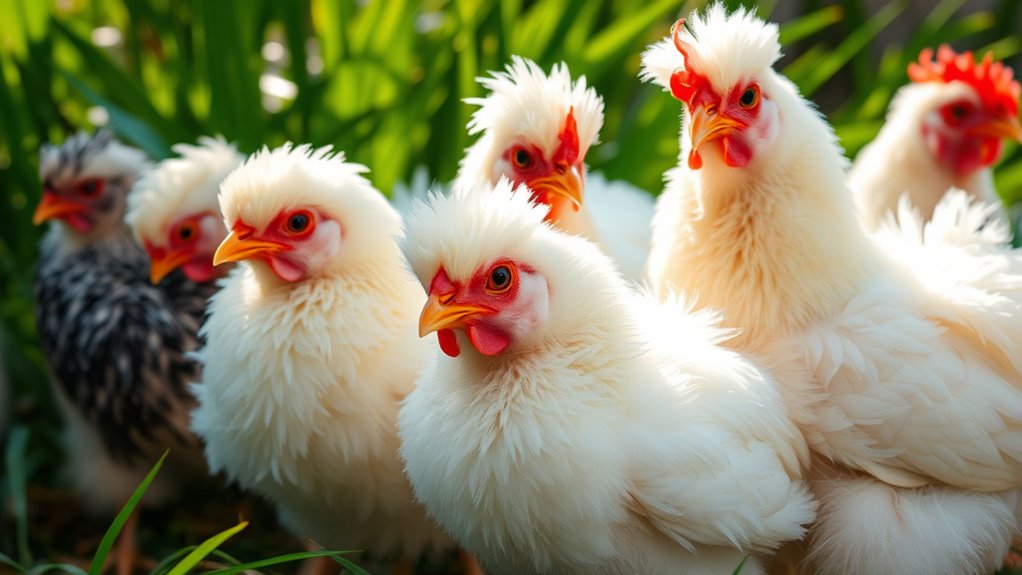
When it comes to fluffy chicken breeds, you've got several delightful options to choose from.
The Silkie stands out with its soft feathers and friendly personality, making it a favorite among pet lovers.
The Silkie's soft feathers and friendly nature make it a beloved choice for those seeking a charming pet chicken.
If you prefer larger birds, the Cochin is an impressive choice, boasting abundant plumage that covers its legs and feet.
The Faverolle, medium to large in size, has dense feathers and even five-toed feet, adding to its charm.
The Polish chicken, known for its distinctive crested head, brings a unique flair, while the Brahma, very large and fluffy, impresses with its beauty.
Each breed not only looks lovely but also has its own personality traits, making them wonderful additions to any flock.
Unique Characteristics of Fluffy Chickens
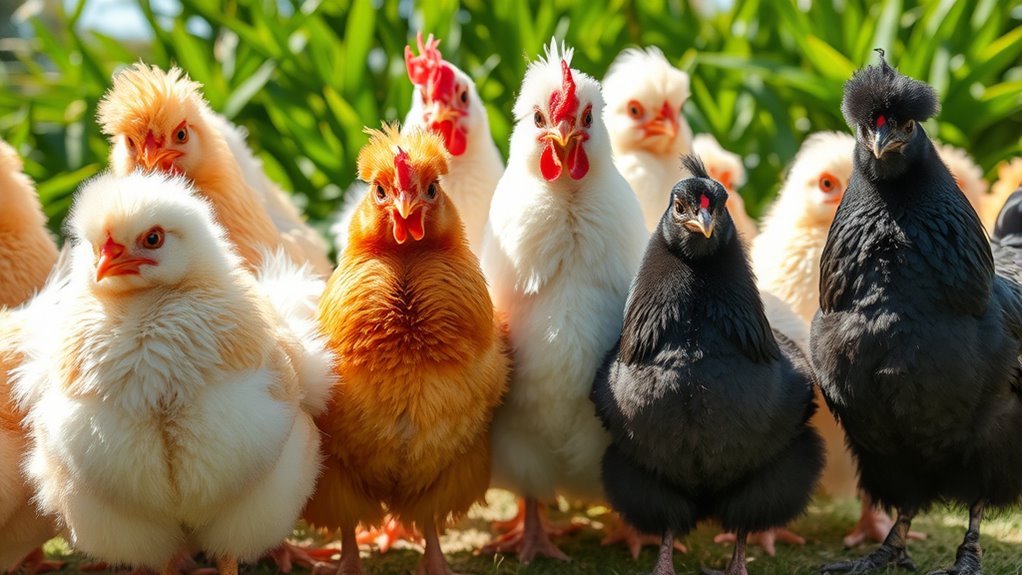
Fluffy chickens are truly special, boasting a variety of unique characteristics that set them apart from other breeds. Their feathers often lack barbs, giving them a soft, fur-like appearance, especially in Silkies.
You might notice some breeds, like Silkies, have striking black skin and bones beneath their fluffy coats. Unique blue earlobes and five toes instead of the usual four are other distinct traits found in certain breeds.
Behaviorally, these chickens tend to be friendly and social, making them delightful pets. Many, like Faverolles, are talkative and enjoy interacting.
Some breeds, such as Silkies, are naturally broody, while others, like Ameraucanas, lay uniquely colored eggs. All these traits contribute to their charm and appeal.
Essential Care and Housing Requirements
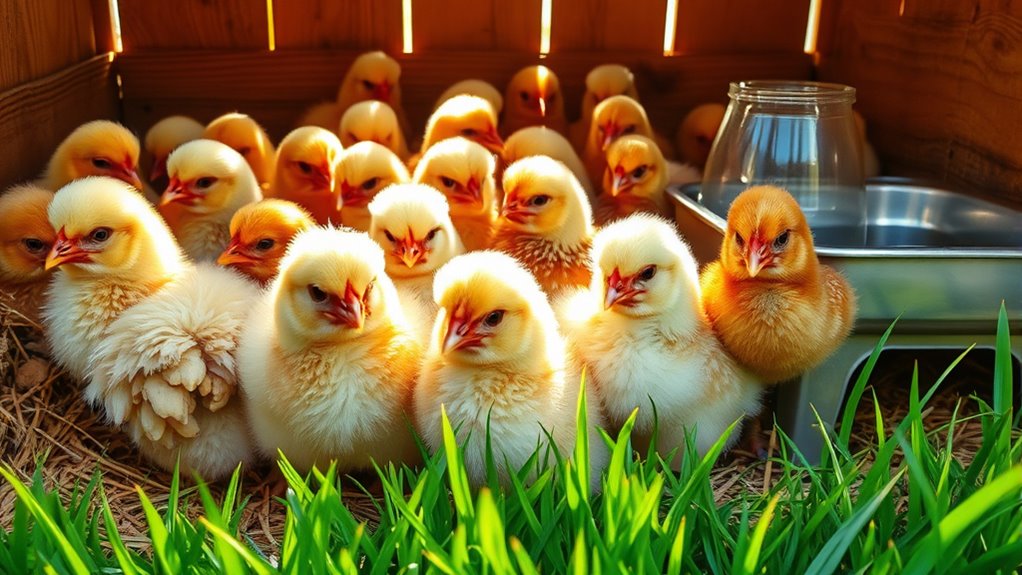
Creating a comfortable and safe environment for your fluffy chickens is crucial for their well-being and happiness. Each bird needs at least 2 to 4 square feet of space inside the coop and 8 to 10 square feet in the outdoor run.
Providing ample space and a secure environment is essential for the well-being of your fluffy chickens.
Make sure your coop is secure from predators with sturdy materials and locks. Provide adequate shelter from extreme weather conditions and one nesting box for every three hens in a draft-free area.
Ensure there's enough headroom, install comfortable roosting bars, and maintain good ventilation to prevent moisture buildup. For outdoor time, consider an enclosed run for safe foraging and access to shade.
Keeping these essentials in mind will help your fluffy chickens thrive.
Health Considerations for Fluffy Chickens

Maintaining a safe environment for your fluffy chickens sets the foundation for their overall health.
These breeds are particularly sensitive to temperature, so keep your coop between 65–75°F and ensure it's dry and draft-free to prevent feather matting.
Regularly check for mites and ticks, as their dense feathers can harbor parasites, and encourage dust bathing to help control infestations.
Be vigilant about respiratory issues by avoiding cedar bedding, and provide clean water at all times.
Additionally, monitor for signs of frostbite, especially in cold weather.
Quarantine new chickens to protect your flock's health, and always consult a vet if you notice any signs of illness.
Taking these steps will help keep your fluffy chickens thriving.
Nutrition and Diet for Optimal Health
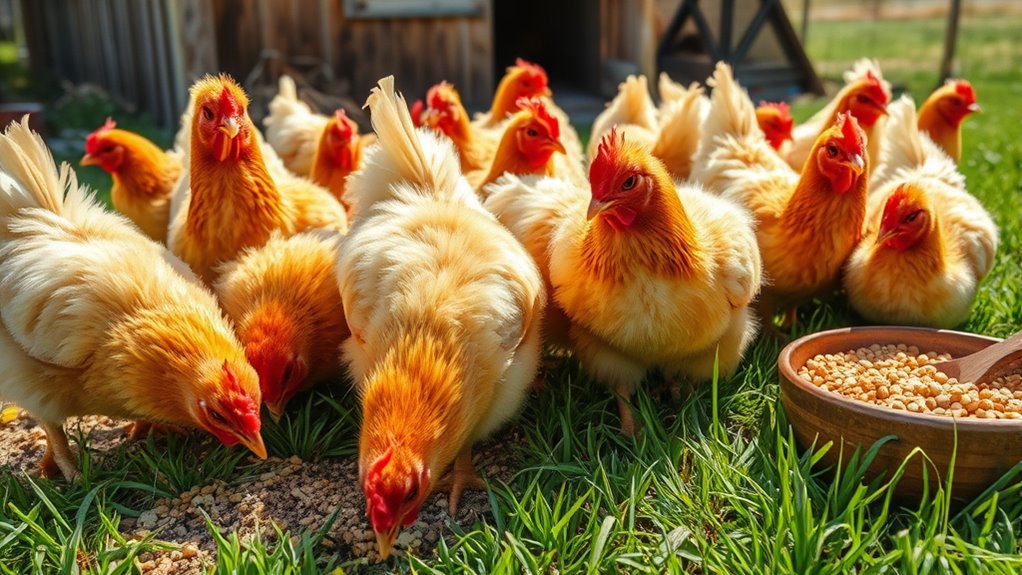
To ensure your chickens thrive, it's essential to focus on their nutrition and diet.
Fluffy chickens need a protein-rich diet, around 16-20%, for healthy feathers and growth. Incorporate carbohydrates and fats from grains like corn and wheat for energy.
Fiber is vital for digestive health, aiding nutrient absorption. Don't forget essential vitamins and minerals such as calcium and phosphorus, supporting overall health and egg production.
Adjust diets based on their life stages: chicks require about 20% protein, while laying hens need 16-18%. During molting, increase protein intake to aid feather regrowth.
Provide calcium sources like oyster shells and consider probiotics for gut health. Always ensure access to fresh, clean water for optimal hydration.
Tips for Successfully Raising Fluffy Chickens
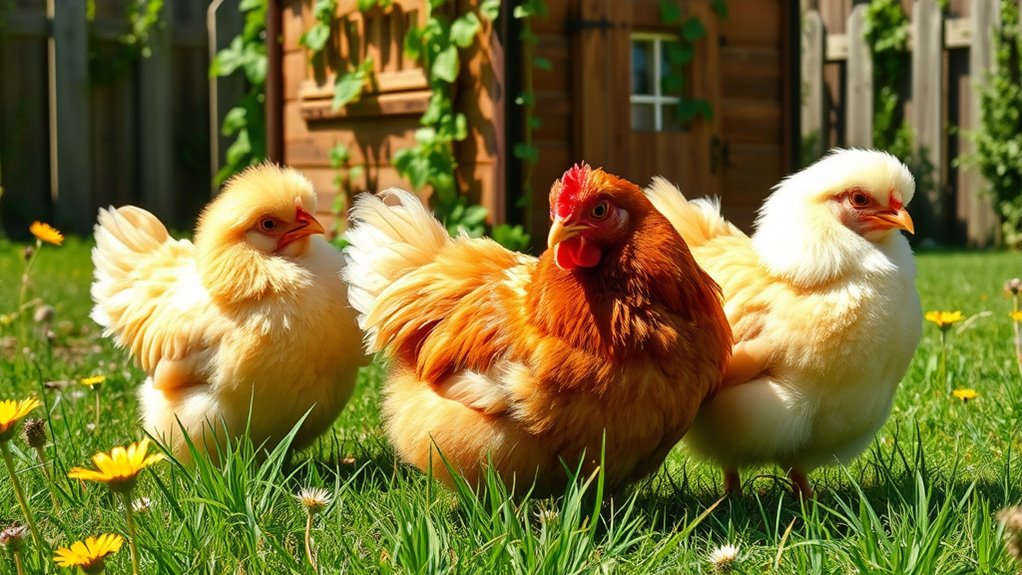
When you decide to raise fluffy chickens, understanding their unique needs is crucial for their well-being and happiness.
Start by selecting breeds like Silkies or Cochins for their friendly nature, but be prepared for lower egg production.
Choose friendly breeds like Silkies or Cochins, but remember they may produce fewer eggs.
Ensure your coop is spacious and provides adequate ventilation to keep them comfortable. Maintain a dry environment to prevent feather matting, and offer shade to protect them from the sun.
Regular health checks and parasite control are essential to keep your fluffy friends healthy. Handle them gently and supervise interactions with children.
Lastly, give extra care to breeds with unique feather types, ensuring they remain clean and well-maintained.
Happy chickens lead to a happy flock!
Managing Social Dynamics in Your Flock
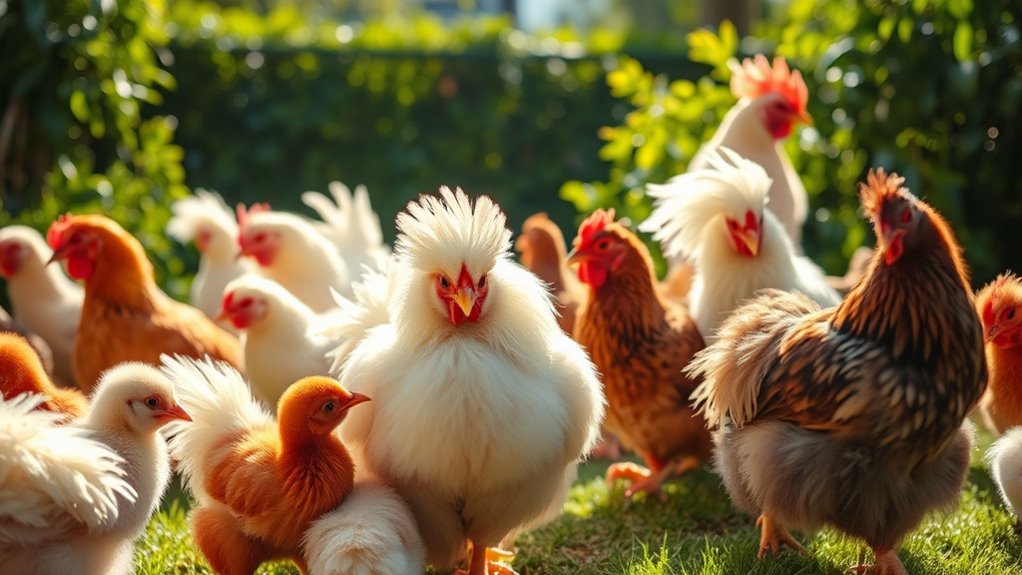
Understanding the social dynamics within your flock is essential for a harmonious environment. The pecking order dictates each chicken's status, influencing access to food and roosting spots. Dominant chickens assert themselves through pecking and posturing, while submissive ones avoid confrontation.
When introducing new birds or facing losses, be prepared for the pecking order to shift, which can lead to stress and aggression.
To manage flock dynamics, provide ample space and multiple feeding stations to reduce conflict. Gradual introductions help ease aggression and promote smoother integration.
Monitor interactions closely, as strong social bonds can alleviate stress. If conflicts arise, separate aggressive birds temporarily and ensure everyone has enough resources to maintain peace within your flock.
Seasonal Care Adjustments for Fluffy Chickens
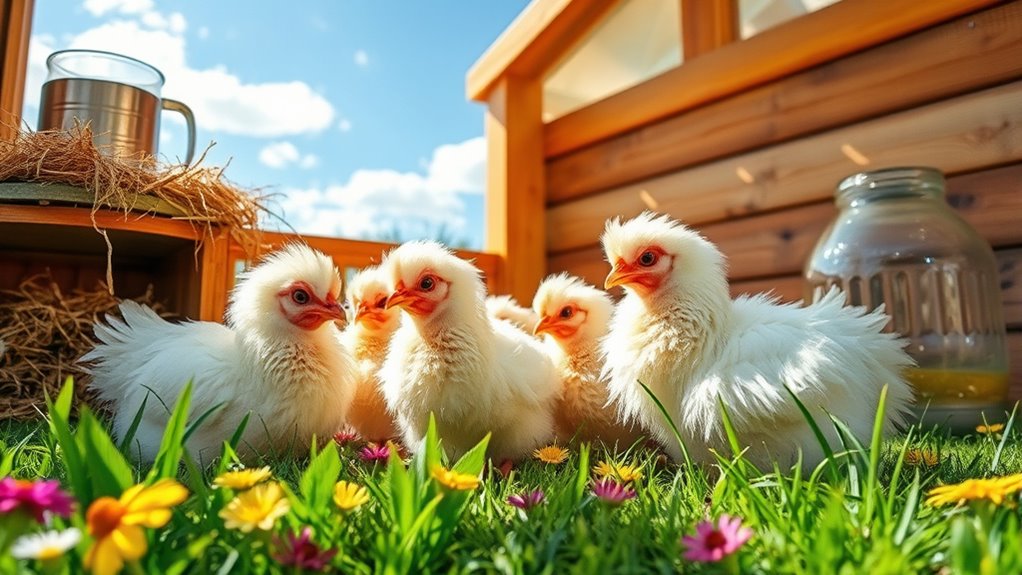
As the seasons change, you'll need to adjust your care routine for fluffy chickens to keep them healthy and comfortable.
In winter, ensure their coop is draft-free and insulated, and consider using nipple-style water systems to prevent freezing.
During summer, provide ample shade and good ventilation to combat heat stress.
Spring calls for thorough coop cleaning and nesting box preparation, while also monitoring for parasites.
In autumn, manage feather molting by offering a nutritious diet to support their needs.
Regular health checks are essential year-round to catch any issues early, especially with dense feathers that can hide parasites.
Adjusting these care practices will help keep your fluffy chickens thriving through every season.
Frequently Asked Questions
How Do I Introduce New Fluffy Chickens to My Flock?
To introduce new fluffy chickens to your flock, start by quarantining them for two weeks.
Choose breeds with similar temperaments and set up separate enclosures for them to interact safely.
Introduce new chickens in the evening when the existing flock is calm.
Gradually integrate them over days, monitor their behavior, and provide separate feeding areas.
Keep an eye on aggression and intervene if necessary to ensure a smooth transition for all your chickens.
Can Fluffy Chickens Live in a Mixed-Breed Coop?
You might be surprised to find that fluffy chickens can thrive in a mixed-breed coop.
They're social creatures and can adapt well, especially if you introduce them gradually. Just keep an eye on temperament; gentler breeds could face bullying.
Also, ensure you provide enough space and protection to prevent any mishaps.
With the right care and setup, your mixed flock can live harmoniously, bringing joy and diversity to your backyard.
What Are the Best Bedding Materials for Fluffy Chickens?
When choosing bedding materials for your chickens, consider hemp for its high absorbency and antibacterial properties.
Wood shavings are economical and comfortable, while straw provides good drainage but less absorbency.
Sand can be a practical option, though it might get too hot.
Coffee grounds add aroma and absorb moisture well.
Just make sure you maintain cleanliness to ensure a safe and healthy environment for your flock.
Do Fluffy Chickens Require Special Grooming Tools?
Absolutely, fluffy chickens require special grooming tools that'll make them look like royalty!
You'll need a wide-toothed comb for detangling those luxurious feathers, a soft brush for daily maintenance, and blunt-tipped scissors for delicate trims.
Nail clippers designed for small animals are essential, too.
Regular grooming keeps their feathers healthy and shiny, so don't skip out on these tools if you want your fluffy companions to feel fabulous every day!
How Can I Tell if My Fluffy Chicken Is Happy?
To tell if your fluffy chicken is happy, observe its behaviors.
Look for active foraging and social interactions with other chickens. Happy chickens often make soft clucking sounds and maintain clean, well-groomed feathers.
Check if they're exploring their environment and have a healthy appetite. Bright, alert eyes and regular egg laying are good indicators too.
Provide a clean space, enough room, and protection from predators to keep them content and thriving.
Conclusion
Raising fluffy chickens is like nurturing a garden; it flourishes with care and attention. As you tend to their needs, remember that each feathered friend adds richness to your life, just as each bloom brightens a garden. Embrace the joy of their quirks and the warmth of their companionship. With patience and love, your flock will thrive, reminding you that in the simplest of creatures, you can find profound happiness and connection. So, let your garden of fluff grow!

